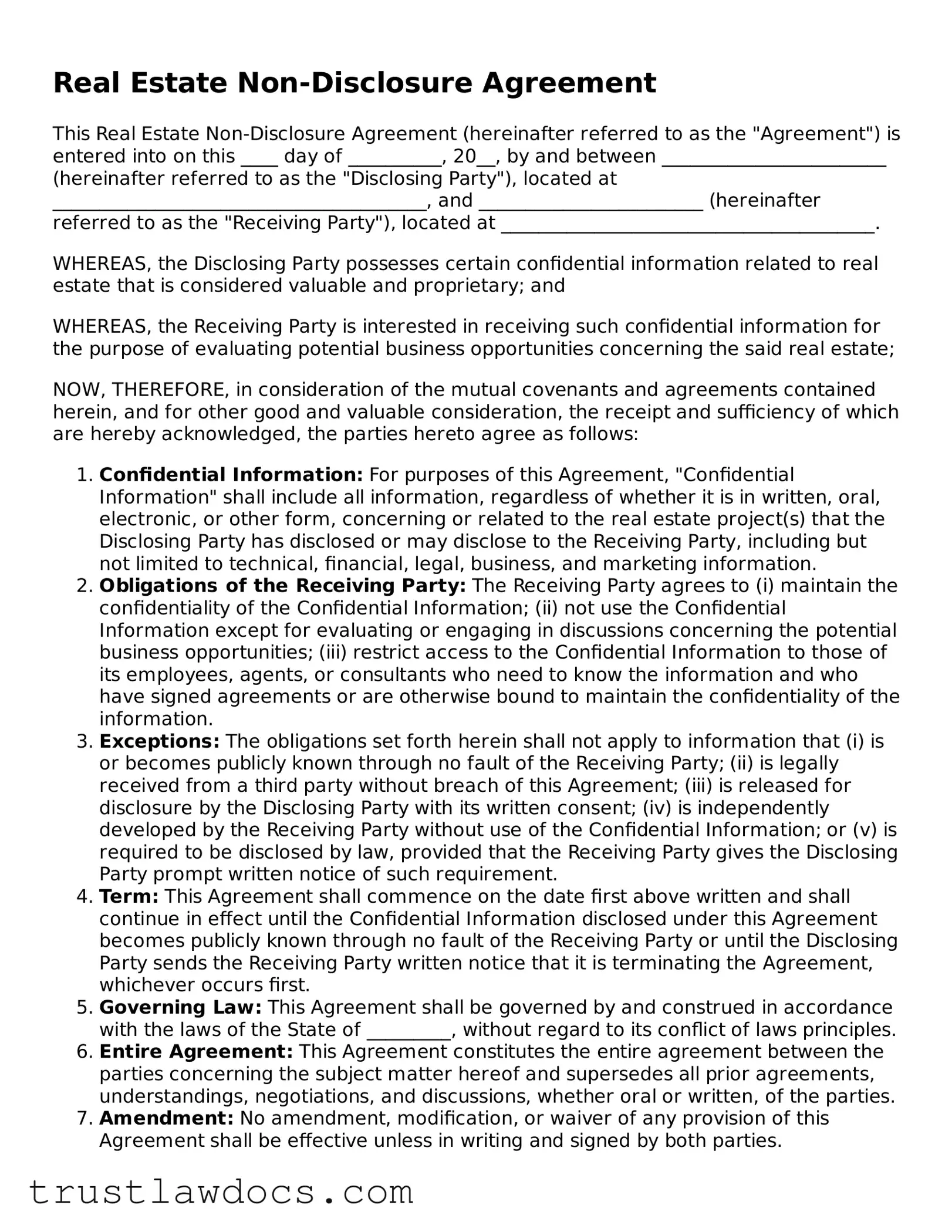Real Estate Non-Disclosure Agreement
This Real Estate Non-Disclosure Agreement (hereinafter referred to as the "Agreement") is entered into on this ____ day of __________, 20__, by and between ________________________ (hereinafter referred to as the "Disclosing Party"), located at ________________________________________, and ________________________ (hereinafter referred to as the "Receiving Party"), located at ________________________________________.
WHEREAS, the Disclosing Party possesses certain confidential information related to real estate that is considered valuable and proprietary; and
WHEREAS, the Receiving Party is interested in receiving such confidential information for the purpose of evaluating potential business opportunities concerning the said real estate;
NOW, THEREFORE, in consideration of the mutual covenants and agreements contained herein, and for other good and valuable consideration, the receipt and sufficiency of which are hereby acknowledged, the parties hereto agree as follows:
- Confidential Information: For purposes of this Agreement, "Confidential Information" shall include all information, regardless of whether it is in written, oral, electronic, or other form, concerning or related to the real estate project(s) that the Disclosing Party has disclosed or may disclose to the Receiving Party, including but not limited to technical, financial, legal, business, and marketing information.
- Obligations of the Receiving Party: The Receiving Party agrees to (i) maintain the confidentiality of the Confidential Information; (ii) not use the Confidential Information except for evaluating or engaging in discussions concerning the potential business opportunities; (iii) restrict access to the Confidential Information to those of its employees, agents, or consultants who need to know the information and who have signed agreements or are otherwise bound to maintain the confidentiality of the information.
- Exceptions: The obligations set forth herein shall not apply to information that (i) is or becomes publicly known through no fault of the Receiving Party; (ii) is legally received from a third party without breach of this Agreement; (iii) is released for disclosure by the Disclosing Party with its written consent; (iv) is independently developed by the Receiving Party without use of the Confidential Information; or (v) is required to be disclosed by law, provided that the Receiving Party gives the Disclosing Party prompt written notice of such requirement.
- Term: This Agreement shall commence on the date first above written and shall continue in effect until the Confidential Information disclosed under this Agreement becomes publicly known through no fault of the Receiving Party or until the Disclosing Party sends the Receiving Party written notice that it is terminating the Agreement, whichever occurs first.
- Governing Law: This Agreement shall be governed by and construed in accordance with the laws of the State of _________, without regard to its conflict of laws principles.
- Entire Agreement: This Agreement constitutes the entire agreement between the parties concerning the subject matter hereof and supersedes all prior agreements, understandings, negotiations, and discussions, whether oral or written, of the parties.
- Amendment: No amendment, modification, or waiver of any provision of this Agreement shall be effective unless in writing and signed by both parties.
- Severability: If any term or other provision of this Agreement is found to be invalid, illegal, or incapable of being enforced by any rule of law, or public policy, all other conditions and provisions of this Agreement shall nevertheless remain in full force and effect.
IN WITNESS WHEREOF, the parties have executed this Agreement as of the date first above written.
Disclosing Party: ________________________________________
Signature: _________________________________ Date: _______________
Print Name: ___________________________________
Receiving Party: ________________________________________
Signature: _________________________________ Date: _______________
Print Name: ___________________________________
